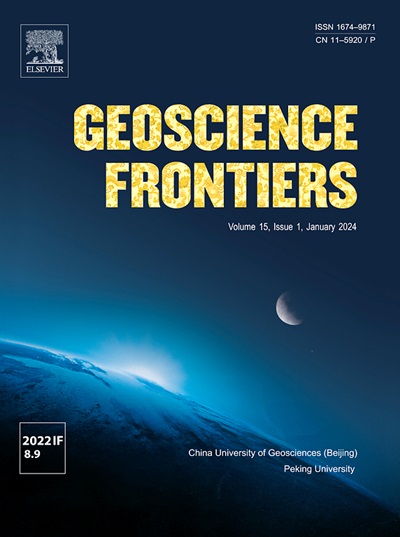Spatial heterogeneity of groundwater depths in coastal cities and their responses to multiple factors interactions by interpretable machine learning models
IF 8.9
1区 地球科学
Q1 GEOSCIENCES, MULTIDISCIPLINARY
引用次数: 0
Abstract
Understanding spatial heterogeneity in groundwater responses to multiple factors is critical for water resource management in coastal cities. Daily groundwater depth (GWD) data from 43 wells (2018–2022) were collected in three coastal cities in Jiangsu Province, China. Seasonal and Trend decomposition using Loess (STL) together with wavelet analysis and empirical mode decomposition were applied to identify tide-influenced wells while remaining wells were grouped by hierarchical clustering analysis (HCA). Machine learning models were developed to predict GWD, then their response to natural conditions and human activities was assessed by the Shapley Additive exPlanations (SHAP) method. Results showed that eXtreme Gradient Boosting (XGB) was superior to other models in terms of prediction performance and computational efficiency (R2 > 0.95). GWD in Yancheng and southern Lianyungang were greater than those in Nantong, exhibiting larger fluctuations. Groundwater within 5 km of the coastline was affected by tides, with more pronounced effects in agricultural areas compared to urban areas. Shallow groundwater (3–7 m depth) responded immediately (0–1 day) to rainfall, primarily influenced by farmland and topography (slope and distance from rivers). Rainfall recharge to groundwater peaked at 50% farmland coverage, but this effect was suppressed by high temperatures (>30 °C) which intensified as distance from rivers increased, especially in forest and grassland. Deep groundwater (>10 m) showed delayed responses to rainfall (1–4 days) and temperature (10–15 days), with GDP as the primary influence, followed by agricultural irrigation and population density. Farmland helped to maintain stable GWD in low population density regions, while excessive farmland coverage (>90%) led to overexploitation. In the early stages of GDP development, increased industrial and agricultural water demand led to GWD decline, but as GDP levels significantly improved, groundwater consumption pressure gradually eased. This methodological framework is applicable not only to coastal cities in China but also could be extended to coastal regions worldwide.

基于可解释机器学习模型的沿海城市地下水深度空间异质性及其对多因素相互作用的响应
了解地下水对多因素响应的空间异质性对沿海城市水资源管理具有重要意义。本文收集了江苏省三个沿海城市43口井(2018-2022年)的日地下水深度(GWD)数据。采用黄土季节和趋势分解(STL)、小波分析和经验模态分解对受潮井进行识别,剩余井采用层次聚类分析(HCA)进行分组。建立机器学习模型来预测GWD,然后通过Shapley加性解释(SHAP)方法评估它们对自然条件和人类活动的反应。结果表明,eXtreme Gradient Boosting (XGB)在预测性能和计算效率方面优于其他模型(R2 >;0.95)。盐城和连云港南部GWD大于南通,且波动较大。海岸线5公里内的地下水受到潮汐的影响,与城市地区相比,农业地区受到的影响更为明显。浅层地下水(3-7米深)对降雨立即(0-1天)作出反应,主要受农田和地形(坡度和与河流的距离)的影响。降雨对地下水的补给在农田覆盖率达到50%时达到峰值,但这种效应受到高温(30°C)的抑制,高温随着距离河流的增加而加剧,尤其是在森林和草地中。深层地下水(10 m)对降雨(1-4天)和温度(10 - 15天)的响应滞后,GDP是主要影响因素,其次是农业灌溉和人口密度。在低人口密度地区,耕地有助于维持稳定的GWD,而耕地覆盖率过高(>90%)导致过度开发。在GDP发展初期,工农业用水需求增加导致GDP下降,但随着GDP水平的显著提高,地下水消耗压力逐渐缓解。该方法框架不仅适用于中国沿海城市,而且可以推广到世界沿海地区。
本文章由计算机程序翻译,如有差异,请以英文原文为准。
求助全文
约1分钟内获得全文
求助全文
来源期刊

Geoscience frontiers
Earth and Planetary Sciences-General Earth and Planetary Sciences
CiteScore
17.80
自引率
3.40%
发文量
147
审稿时长
35 days
期刊介绍:
Geoscience Frontiers (GSF) is the Journal of China University of Geosciences (Beijing) and Peking University. It publishes peer-reviewed research articles and reviews in interdisciplinary fields of Earth and Planetary Sciences. GSF covers various research areas including petrology and geochemistry, lithospheric architecture and mantle dynamics, global tectonics, economic geology and fuel exploration, geophysics, stratigraphy and paleontology, environmental and engineering geology, astrogeology, and the nexus of resources-energy-emissions-climate under Sustainable Development Goals. The journal aims to bridge innovative, provocative, and challenging concepts and models in these fields, providing insights on correlations and evolution.
 求助内容:
求助内容: 应助结果提醒方式:
应助结果提醒方式:


